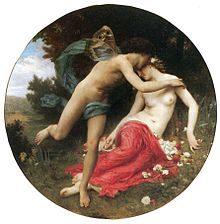Flora (mythology)
Flora is the goddess of the flower in Roman mythology , especially the cereal flower .
narrative


In Ovid it is with the otherwise unoccupied Greek nymph Chloris equated:
"And while she was speaking, she breathed spring roses out of her mouth: I was Chloris, whom I am called Flora."
In the spring she is pursued by the personification of the west wind Zephyr and made his wife.
It belongs to the circle of the gods of vegetation , the gods of the earth and of agriculture, and is related to Ceres , Demeter and Tellus . Their veneration can be demonstrated among the Oscars and Sabellian tribes of the central Apennines . Flora was also the goddess of youth and joyful enjoyment of life, ultimately also of pregnancy , of which the flower is the symbol.
Their veneration is said to have been introduced into Rome by the Sabine king Titus Tatius ; according to others, Numa Pompilius is said to have installed a Flemish Floralis for them. At their festival ( Floralia ) people decorated the apartments and themselves with flowers, the women dressed in bright colors contrary to the usual custom, and singing, dancing and dining filled the festive season. After the First Punic War , Flora also had its own circus games, the ludi florales , which took place from April 28 to May 3 , in which, instead of wild predators, so-called small game , i.e. H. Rabbits, deer, etc., was killed. Hetaera also undressed as the embodiment of the goddess and her followers in front of the audience.
Flora had two temples in Rome, one on the Quirinal , the other near the Circus Maximus . The artists depicted the flora similar to a Greek spring hora, as a blooming, flower-adorned virgin. The most famous of the three - dimensional representations is the so-called Farnese flora , a larger-than-life marble figure that is now in the National Archaeological Museum of Naples.
Trivia
The wax bust of the flora was widely considered to be one of the most famous sculptural works from the circle of Leonardo da Vinci , but has since been unmistakably revealed as a creation of the 19th century.
Flora embodies spring in the allegorical depictions of the four seasons .
See also
literature
- Lorenzo Fabbri: Mater Florum. Flora e il suo culto a Roma. (Biblioteca dell'Archivum Romanicum). Leo S. Olschki, Florence 2019.
- Fritz Graf : Flora. In: The New Pauly (DNP). Volume 4, Metzler, Stuttgart 1998, ISBN 3-476-01474-6 , column 561 f.
- V. Hošek: Flora . In: Lexicon Iconographicum Mythologiae Classicae (LIMC). Volume IV, Zurich / Munich 1988, pp. 137-139.
- Steuding: Flora 1 . In: Wilhelm Heinrich Roscher (Hrsg.): Detailed lexicon of Greek and Roman mythology . Volume 1,2, Leipzig 1890, Sp. 1483-1486 ( digitized version ).
- Georg Wissowa : Religion and cult of the Romans. 2nd Edition. 1912, pp. 197f.
Web links
- Flora in the Roman Myth Index (English)
- Chloris in the Theoi Project (English)
- Julius S. Held, Ulrich Rehm: Flora . In: Reallexikon zur Deutschen Kunstgeschichte , Volume IX (2001), Sp. 1306–1348.
Individual evidence
- ↑ a b c d Flora . In: Meyers Konversations-Lexikon . 4th edition. Volume 6, Verlag des Bibliographisches Institut, Leipzig / Vienna 1885–1892, p. 379.
- ^ Ovid Fasti 5, 195 ff.
- ↑ Heribert Hunger: Lexicon of Greek and Roman Mythology. Brothers Holliner publishing house, Vienna 1959, p. 115.
- ^ Matthias Schulz: Heroes put to the test . In: Der Spiegel . No. 3 , 2008, p. 114 ( online ).

